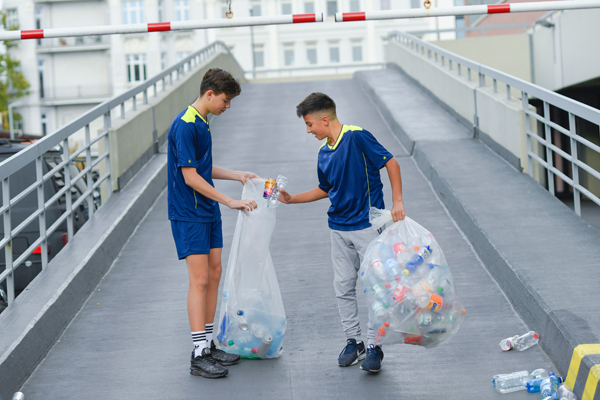We live in a world where the handling of plastic waste is being challenged by disruptive recycling and waste management trends. Global awareness of plastic pollution is rising, with oceans being littered at a rate that forecasts they will contain more plastics than fish by 2050.
Yet only 14% of plastic packaging is being collected for recycling, and only 9% of the total amount of plastic ever produced has been recycled. To combat this negative trend, countries around the world are committing to more aggressive measures to get the problem under control. One tool in the campaign against plastic waste that is being implemented at a rapid pace is container deposit return systems for drink containers.
Here, we explore the rise in popularity of deposit return systems, why there is interest in them, and how these systems can facilitate a more sustainable handling of beverage waste.
What is a deposit return system?
"A deposit return system (or deposit return scheme or DRS, known as a container deposit scheme or bottle bill in some parts of the world) motivates people to recycle by placing a small deposit on the sale of beverage containers, which is refunded when consumers return the empty containers for recycling," explained Wolfgang Ringel, Senior Vice-President of Group Public Affairs at TOMRA (see image below). TOMRA has 50 years' experience in deposit return systems, working in 40 deposit markets, in every part of the value chain.
Deposit return systems are typically established through legislation passed by state or national governments, to increase levels of recycling and reduce littering within their regions.
Policy shifts
"The collective behavioral and political shifts of governments, policymakers and consumers, combined with the environmental impact of plastic pollution, have created a demand for improved waste handling systems to be introduced," said Wolfgang Ringel.
Stricter exporting regulations such as China’s "National Sword", launched in 2017, have seen China’s waste imports fall by 99% and responsibility placed on the exporting countries to handle their own waste more responsibly and domestically. Plastic waste has now been classified as hazardous by the Basel Convention, and alongside these new policies is the growing aspiration to shift away from a linear economy's "take, make, dispose" model to a more circular approach, to ensure material is reused or recycled as many times as possible.
The United Nations (UN) is also rising to the challenge. In 2017, the UN General Assembly passed a resolution encouraging members to adopt "innovative" approaches to marine pollution, such as deposit return systems, as it called for greater action "to prevent and significantly reduce marine pollution of all kinds" by 2025. Recently, 175 countries, led by the UN, agreed to set a legally-binding treaty by 2024 that would manage plastic pollution. In July 2022, the United Nations General Assembly also recognized the human right to a clean, healthy and sustainable environment, through Resolution 76/300.
In 2019, the European Union (EU) adopted the Single-Use Plastics Directive, which seeks to transform the way plastic products are designed, used, produced and recycled. This Directive mandates that EU member states separately collect 90% of plastic beverage containers by 2029, with a requirement for beverage bottles to be made from 25% recycled PET (rPET) by 2025, and 30% by 2030. Experts say that achieving such targets will be difficult without a deposit return system in place, due to the relatively low collection rates from non-deposit collection systems.
The current surge in crude-oil prices, the greatest since the 1970s, can also lead to an increase in the price of virgin plastic, creating demand for the kind of high-quality recycled PET that can be delivered by a deposit return system.
Commitments and expansions toward DRS
The last decade has seen huge growth in deposit return systems. More than 40 markets around the world already have in operation deposit return systems for the collection of beverage containers for recycling. Many states or countries have also committed to update existing deposit systems or develop new systems. Should these programs be implemented, it’s estimated that nearly 600 million will have access to DRSs for recycling their empty beverage containers, doubling the number of individuals covered compared to 2018 (290 million).
So far in 2022, Slovakia (January) and Latvia (February) have gone live with local DRSs. The Netherlands and Germany are among markets that have committed to expanding their existing deposit systems in 2022, for example to include more container materials/sizes and beverage types.
"When it comes to analyzing trends across regions for deposit return systems, there have been commitments at both country and state levels for DRSs, with a major uptake evident across Europe, as EU member states seek to reach targets set out in the Single-Use Plastics Directive. Elsewhere, Australia, which already has multiple state-level DRSs in operation, will become the first entire continent to operate a DRS in all jurisdictions, with Tasmania and Victoria recently committing to establish deposit systems," explained Wolfgang Ringel.
"In the US, nine states proposed adding a new bottle deposit system in 2021 and all ten states with existing deposit systems filed legislation to update their programs to be more effective. The Canadian province of Quebec recently committed to modernizing its existing deposit system in several ways, including adding deposits to popular beverage categories and making the deposit value more meaningful. Singapore, Jamaica and Guadeloupe are also having open conversations about DRS."
And it is not only countries/states and their governments supporting DRS. In addition, a range of organizations within the beverage and packaging industries have expressed interest in well-designed deposit return systems as a way to effectively capture more used beverage containers and increase the amount of recycled content used in new containers. Supporters include the European Federation of Bottled Waters, the Union of EU Soft Drink Associations (UNESDA), Nestle and all three major beverage packaging trade associations in the US.




